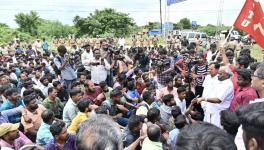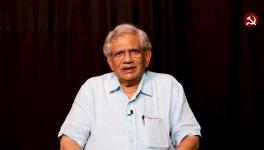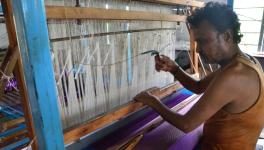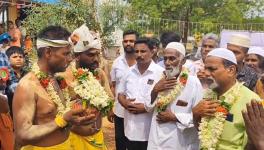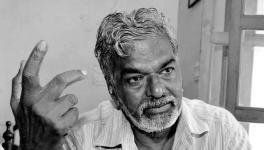“There is No Such Thing as Equality Anywhere, We Need to Bring About Resistance”
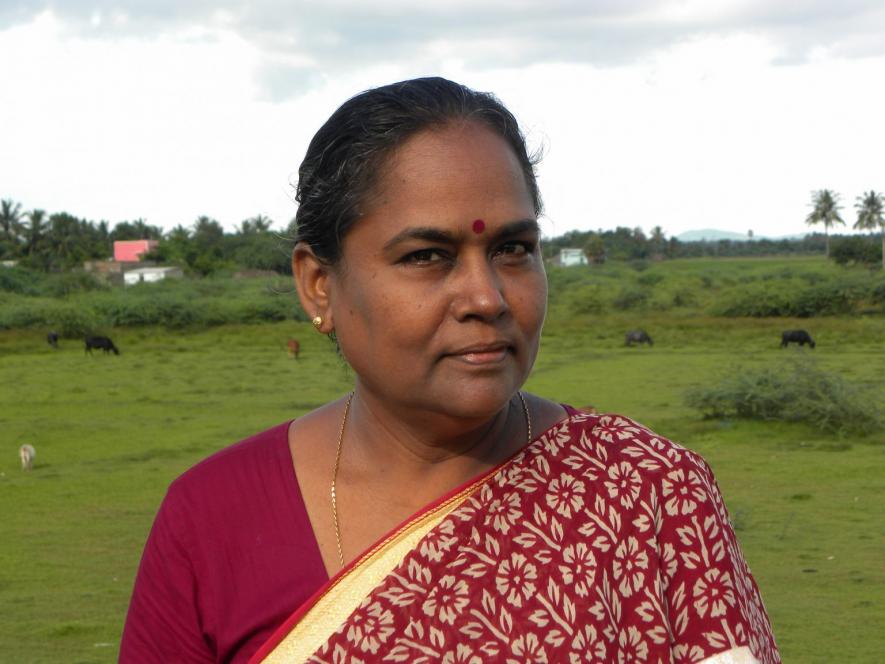
Last month, the Oversight Committee of the Delhi University removed selections from Bama’s Sangati from the English Honours syllabus.
Bama, a Dalit writer, was born in 1957, at Pudupatti in Tamil Nadu. Fighting against impossible odds she went through school and college and trained as a teacher, and as such, tries to impart values aimed at building self-esteem and social consciousness. Besides Karukku, her first book, she has published Sangati (Events); Kisumbukkaran (Harum-Scarum Saar); Vanmam (Vendetta); Oru Thathavum Erumayum (A Buffalo and a School of Thought); Kondattam (Celebration); and Manushi (Woman) in Tamil. The English translation of Karukku won the Crossword Book Award in 2000.
In her novels as well as in her many articles, Bama focuses on themes related to caste domination and social discrimination. Her books have been translated into English, French, Telugu, Kannada, Malayalam and Gujarati. Bama’s significant contribution is that, through the act of writing, she not only transgresses caste boundaries, she also demolishes the conventional exclusions of language and genre. Bama spent some years in a convent as a nun before becoming one of the most celebrated contemporary Dalit women writers. She has been at the forefront of Dalit literary activism and has given Dalit aesthetics a visibility it had previously lacked.
K Srilata and Swarnalatha Rangarajan (KS & SR): We have learnt much about your life from your two books, Karukku and Sangati, which offer moving vignettes about your life in the convent, your struggles on leaving it and your persistent attempts to shrug off the shadow of caste that follows you wherever you go. Your writing has triggered a wave of social awareness and empathy in students and young people who can access it through translations and are able to understand a Dalit perspective. We think your storytelling has a very natural quality. Is this talent an innate ability? When did you decide to transmute your life experiences into the written form?
Bama (B): To answer your first question, I should say that storytelling is our culture. We grow up listening to stories, begin listening to them perhaps right from birth. When I was a child, my grandmother and mother used to tell me a lot of stories. There were many others. The school was an important source of stories—our curriculum consisted of a lot of stories, unlike today’s education that attaches importance only to rigorous academic training. To elaborate, we had few or no books, we used to carry only a writing slate and maybe a few vaipadu[1] books to help us memorise multiplication tables and the like. The important things were stories!
KS & SR: Where did you attend school?
B: I attended school in my village, Pudupatti. If the school gave me stories, the religious context of my background also provided rich stories, from the Bible. In short, we were surrounded by stories, there were stories wherever we turned. That’s how we grew up. And so I think our culture is a storytelling culture. It may not be written but surely it is oral. As we had grown up listening to stories they inevitably took root, and when we became adults they enabled us to become storytellers ourselves. People from my grandmother’s generation were so good at it that they invented stories! We came to know more about the Ramayana and Mahabharata through the stories they shared with us, than from our school books. There was a plenitude of stories in our growing years. Thinking back, I feel that these stories had sustained, strengthened, and cheered me during those spells of pain, agony I experienced, the hard labour, poverty and other challenges.
To answer the question of how I came to write, I must point out that I didn’t start writing under pressure or because I was forced to. As you know, I had left the convent in 1991. This was a painful moment for me. As a sixty year old woman, I’ve come across many difficulties, but leaving the convent was one of the darkest moments in my life. I had left my job as a teacher to join the convent and when I left the convent, I was economically vulnerable. I experienced psychological difficulties, too. When I was going in, leaving the outside world behind was so difficult because everything was unfamiliar. When I left the convent after seven years, leaving the convent was difficult because I was going out into a world that had now become unfamiliar to me. The outside world seemed alien. I was unable to converse and socialise normally with people. I felt that I was unfit to restart my life. This feeling was most pronounced when I was travelling. I felt I was all alone and surrounded by strangers when I travelled in the bus. Clothing and food were also a problem because I didn’t have a job. I had only three or four sets of clothes. I didn’t want to go home to my parents and seek their support. I stayed on in Madurai and found a job that paid me a thousand rupees per month and I depended on it for food, travel and everything else. My earlier job paid handsomely and so the difference between what I was earning before and what I earned then was huge and obvious to me.
Writing resulted in mixed feelings, because there were teary moments when I recalled the pleasures and fun times of childhood that could never be relived.
But psychological survival was a bigger challenge to me than economic survival. During those seven years in the convent I had lost contact and communication with all the people I’d known, because we were required to cut all contact with the outside world. I found it really difficult to reconnect with the people I knew, even my own relatives and siblings. I was also reluctant to go out and meet new people. I was unable to return to my native village because leaving the convent was considered a disgraceful act by my people, that brought shame to my parents. Leaving the convent was a conscious decision. However, I was worried about how the gossip-mongers would interpret my action. I knew that they would go round spreading tales like, “She must have done something wrong!” and “She must have had an affair!” and other such hurtful things. They said all that about me anyway. They also said, “She’s been chased away by them. She can’t find a job now because they’ve taken away her certificates!” I longed for the familiarity of my hometown and felt miserable about my inability to go back. I longed for my mother who was my staunch supporter. She told me to return, but my father wasn’t too keen on having me back. In that situation, recalling my childhood made me think that that time was indeed a heaven. In the convent we got everything, but the small comforts and joys of being at home and seeing familiar faces and loved ones always brings more happiness, even if the economic situation is less than ideal. I felt the loss of my childhood comforts deeply. I longed to go back to it.
It was Fr. Mark, a Jesuit priest from my village and my brother’s friend, who got me my first job. When I shared the difficulties of my life with him, tears would always come to my eyes. He suggested that I write all my feelings down in a notebook as a way of liberating myself from the burdens of my heart. He too was very busy and didn’t have much time to listen patiently to my problems. For nearly six months, I kept up the practice of writing everything down in a notebook. Writing resulted in mixed feelings, because there were teary moments when I recalled the pleasures and fun times of childhood that could never be relived. Those six months saw periods of frenetic, engaged writing as well as times when my creativity slackened.
KS & SR: Was this when you were working at the job that paid a thousand rupees a month?
B: Yes, this writing was from that period. I worked for about six months in that job. I went on to apply for a job as a teacher, cleared the interview, and got the job. When I showed my writing to Fr. Mark, he was very happy and pleased with my progress. He said that my writing had the potential to be published and appreciated as a good piece of literature. But I wasn’t too interested in getting it published because I had written it like a personal diary, without changing any of the names of people and places. Another thing was that whenever I wrote about my village, I slipped into the colloquial register. Convent language was used everywhere else because I had left my home to be at the convent. My initial readers liked the colloquial language I had used in parts and advised me to change everything to that register. I took their advice and did so. Fr. Mark tried very hard to get it out as a book but nobody was willing to take it on. He went to meet a professor in Trichy to get his opinion about my writing. I didn’t go along. When he returned he told me that the professor had thrown my manuscript on the floor.
KS & SR: What didn’t he like about it? Was it the language?
B: No, it was both—language and content. He said sarcastically to my mentor, “You’ve brought this to me like this is some writing!” No publisher was willing to publish it. Later, Fr. Mark, who was working in IDEAS, a centre for social action, published it via the small press owned by them. We brought out a small booklet of my writings priced at twelve rupees. That was how I started writing. But storytelling is something that comes to me very naturally. As a teacher, I still engage with storytelling a lot.
KS & SR: People see you as Dalit writer/thinker. Do you feel that this is a double-edged sword? Caste identity is something that is inescapable in our country, gender identity is also non-negotiable. Is Dalit identity the one that puts it all together?
B: To respond to your first question, I must point out that no matter what identity one takes on, the tag of ‘Dalit’ is always added, despite the multiple identities that I negotiate as ‘woman’, ‘writer,’ ‘teacher’, ‘thinker’.
KS & SR: Is it added even to teachers?
B: Yes. No matter what you do or become, ultimately all that remains is that you’re a Dalit woman. I’ve seen this many times, in others’ and in my own experience. I’m fighting this also. I always get angry when I’m treated that way. The question of why certain classes of people are inferiorised in this way always comes up in my mind. You asked in surprise about Dalit being connected to a teacher’s identity, too. I must mention this incident from the previous school I worked in. The teachers, and even some of the illiterate parents, who would greet me warmly before they knew I was a Dalit, stopped respecting me when they found out. Kumudam magazine interviewed me and published an article on me subsequently. I was very candid in that interview and openly declared my caste status. The mother of one of the students earmarked that article and sent it through the student asking her to show it to me, saying her mother had read it. I understood immediately that it was a move to inform me that they knew my caste. I told that girl that she should leave such attitudes at home and not bring them into the school. The way they treated me after that episode was completely different. It went downhill from there.
Storytelling is something that comes to me very naturally. As a teacher, I still engage with storytelling a lot.
[…]
KS & SR: Some people say that writing an autobiography lacks aesthetics, craftsmanship, and ultimately turns out to be too simplistic. Have you faced criticism like that, especially from the mainstream?
B: In Tamil literature, autobiography is usually about the birth and growth of a very well-known and famous person. My writing is not like that. Secondly, I am a nobody. If you consider people like Abdul Kalam, they can write an autobiography. So far, autobiographies have been written by people like that. In some other instances, biographies are written about a person after they’ve passed away. I am outside both categories, my book falls outside the autobiography genre. When it came out there was this question of whether my book was a novel or an autobiography.
KS & SR: Sangati also falls in this in-between category, doesn’t it?
B: There was a lot of discussion about this among Tamil writers. Finally, many people concluded that it is an autobiography. But as far as I was concerned, it was of no concern to me, because when I was writing it, I didn’t even have the intention of bringing it out as a book. I was writing alone, by myself, and people’s discussions were occurring somewhere else. They were conflicted in themselves as they tried to categorise my book. They came up with new categories such as ‘autobiographical novel’. I was least bothered about these categorisations. The questions that came to my mind were, “Why must I structure my writings according to their discussions? If there is a traditional definition of autobiography, is there any a need for me to stick to it? Can I not write differently? Why should I use only the language that they use? Why can’t I use my own language?” They called my language “filthy” and “ugly”.
The language I had used was raw and has its own beauty. They felt that though it is the language spoken by people, it is dirty. Beauty is subjective to individual perspectives. To each person, her or his mother tongue is beautiful.
[…]
KS & SR: In Sangati, there is evidently a strong Dalit women’s perspective, and it is neither a straightforward novel nor an autobiography. Could you say something about this?
B: In writing Sangati, I intentionally chose women with fighting tendencies. There are many types of characters—those who become disheartened when things don’t turn out favourably, and those who choose resistance and opposition at such times. From a young age, I felt an affinity with the latter because I identified myself as one among them, as one with them, with a tendency to fight back. I always experienced great joy when I saw them triumph. Even in the middle of large crowds, as individual women, they could raise their voices and challenge those who dared to oppose or suppress them. It was always a wonder to me.
Why should I use only the language that they use? Why can’t I use my own language?
They could easily have been physically restrained if two men caught hold of them, yet they dared them and spoke out. I’ve seen this in many contexts, even in quarrels between husbands and wives. The women would start yelling well before they got beaten. People would gather around, hearing the noise. It was a rural place and unlike urban places, people tend to gather when there is a disturbance in the neighbourhood. They would come to the rescue of the woman. She’d yell that he had beaten her and cracked her head, as if he had already done it, well before he’d even begun! Others might think, “Why is she behaving so indecently, lying about getting beaten when she hasn’t been?” But for the woman this is a self-defence mechanism. Her intention is to make people come rushing to the scene upon hearing her screams. Then her husband hesitates to raise his hand against her and it enables her to escape. Women had to endure many situations such as beatings from husbands or sexual harassment from landowners, they had to learn to manipulate such situations in order to avoid being harmed. They had to come up with their own strategies to defend themselves. It is the natural instinct after all! In times of danger, all living beings attempt an escape. They used their gift of the gab to wriggle out of difficult situations. So these were the kind of women I chose to write about. All of them were real people I had seen in my lifetime, some of them have already passed on.
Sometimes they would act really funnily, too. There was this woman who used to carry kuzhu[2] in a flask. We would watch her as we went to school in the morning. She was from our street. She wouldn’t even be wearing a top. We used to be amused and also shocked that she was carrying a flask, and a flask from old times. Though the flask was broken she still carried it around, and responded very innocently to our question about what she was carrying. We named her Maikuzhu Kilavi and used that name in our conversations about her. To an outsider, this would probably appear silly and stupid. But we saw it as enjoyable and funny, something to laugh about. In any circumstance, you can see that we never allowed outside forces to crush us, instead we rose above them. Sangati unfolds like a novel, covering the story of three generations of women. Me, my mother and my grandmother. There’s also another grandmother, her daughter and daughter’s daughter. It is a story of how they choose to understand their lives.
[…]
KS & SR: We have a question about your book, Vanmam which faced a lot of criticism. It discusses the internal hierarchy between pallar and paraiyar …
B: Vanmam is not only about internal conflicts, it is a contemporary issue, a well-known issue in the southern districts. There is a tendency in every human being to oppress the one below. If we examine ourselves, we definitely sense a feeling of pride in the fact that there is someone below us. It’s a feeling that can come about on any account—economic, caste, beauty, academic achievement, etc. This sort of inferiority-superiority feeling is present even among Dalit and marginalised groups. Pallars[3] consider paraiyars[4] below them and paraiyars consider arundathaiyars[5] to be inferior. Arundathaiyars, in turn, consider kuravars[6] to be inferior to them. Hierarchies are present everywhere, including among Dalits. Among Brahmins, hierarchy causes differences between Iyers and Iyengars. It is also evident between Pillai and Vellalar. The result, from a political angle, is that despite having large manpower, we remain divided, with no way of uniting because of our caste affinities. Nearly 20 per cent of India’s population consists of Dalits, and yet they remain separated. Nobody will allow unification.
There is no such thing as equality anywhere. We need to bring about a resistance.
The ruling parties consisting of upper castes have a vested interest in maintaining the lines of separation, they consider unification to be non-beneficial to their prospects. Thus, the two forces, acting externally and internally, keep everybody separated. That’s why people remain stagnant, stay in the same place. Dalit leaders are also not keen to pursue unification, they are only interested in allying with their own castes. In one village the pallar-paraiyar difference lasted for almost a decade until it was finally sorted out by a panchayat committee. The resolution thus reached is temporary, with the possibility of a fight breaking out any time. This is the situation of many caste conflicts in our country, with neither party willing to compromise and give way. We’ve habituated ourselves to operating with a high-low mindset and to seeing somebody below us in every structure.
There is no such thing as equality anywhere. We need to bring about a resistance. Resistance at an individual level is not enough, we need to set up mechanisms of resistance and other checks and balances at institutional levels. But the problem is that some people enjoy this state of affairs and are unwilling to give up the advantage they have over those they consider to be below them. There’s also this parable narrated by Tolstoy, about a fat guy who carries a thin guy. Though the fat man feels pity for the thin man, he refuses to climb down and relieve the thin man of his burden. That is the same mentality that persists in many people. The idea that I can be comfortable and happy at the cost of your difficulties has somehow become okay. That attitude has to change. We have to realise that we’re all the same and that we’re all human beings. We’re all separated on so many levels—between men and women, among castes, among economic classes, etc. India is a complicated country with many such separations. Maybe this is relevant in your social circles, too—there are so many specifications about what not to eat, whom not to love, how not to dress. You are part of an educational institution, but these educational institutions have not paved the way for bringing about the kind of social change we need. Those who come out of them come with the same casteist feelings and ideas. Because of the competitive spirit prevalent everywhere, educational institutions are not too concerned about bringing about a change in society. Instead, the focus is on academic success, academic excellence and on making lots of money. Relationships between fellow human beings and even familial relations are turning complex. Familial relations between siblings have become formal and distant. We can’t call on our relatives without informing them well ahead of our visit… It was not like this in the not too distant past. Previously, we could drop in to see our relatives any time and eat their food freely. That is not the case today. Everything has been compartmentalised, and relationships are so contorted that they can’t even be considered relationships in their original meaning. The basic affection that underlines human conversation is absent most of the time.
Notes:
1. Multiplication tables in Tamil which are committed to memory.
2. Porridge.
3. A caste in Tamil Nadu consisting mostly of agriculturalists.
4. A caste in Tamil Nadu also known as Adi Dravidar. Originally a community of drummers, the paraiyars were forced to take up occupations like scavenging and burying corpses.
5. A schedule caste community found in Tamil Nadu, which originally comprised leather workers.
6. An ethnic Tamil community native to the Kurinji region of southern India. The kuravars were placed under the Criminal Tribes Act of 1871 by the British and stigmatised for a long time, till they were denotified in 1952.
Excerpted with permission from Lifescapes: Interviews with Contemporary Women Writers from Tamil Nadu by K Srilata and Swarnalatha Rangarajan, published by Women Unlimited, Rs 375.
Get the latest reports & analysis with people's perspective on Protests, movements & deep analytical videos, discussions of the current affairs in your Telegram app. Subscribe to NewsClick's Telegram channel & get Real-Time updates on stories, as they get published on our website.











